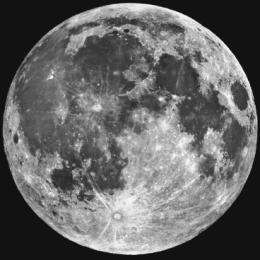What drove the lunar dynamo? Moon's molten core was likely sustained by alternative power source

New evidence from an ancient lunar rock suggests that the moon once harbored a long-lived dynamo — a molten, convecting core of liquid metal that generated a strong magnetic field 3.7 billion years ago. The findings, published today in Science, point to a dynamo that lasted much longer than scientists previously thought, and suggest that an alternative energy source may have powered the dynamo.
“The moon has this protracted history that’s surprising,” says co-author Benjamin Weiss, an associate professor of planetary science at MIT. “This provides evidence of a fundamentally new way of making a magnetic field in a planet a new power source.”
The new paper is the latest piece in a puzzle that planetary scientists have been working out for decades. In 1969, the Apollo 11 mission brought the first lunar rocks back to Earth — souvenirs from Neil Armstrong and Buzz Aldrin’s historic moonwalk. Since then, scientists have probed the rocky remnants for clues to the moon’s history. They soon discovered that many rocks were magnetized, which suggested that the moon was more than a cold, undifferentiated pile of space rubble. Instead, it may have harbored a convecting metallic core that produced a large magnetic field, recorded in the moon’s rocks.
Exactly what powered the dynamo remains a mystery. One possibility is that the lunar dynamo was self-sustaining, like Earth’s: As the planet has cooled, its liquid core has moved in response, sustaining the dynamo and the magnetic field it produces. In the absence of a long-lived heat supply, most planetary bodies will cool within hundreds of millions of years of formation.
A dynamo still exists within Earth because heat, produced by the radioactive decay of elements within the planet, maintains the core’s convection. Models have shown that if a lunar dynamo were powered solely by cooling of the moon’s interior, it would have been able to sustain itself only for a few hundred million years after the moon formed — dissipating by 4.2 billion years ago, at the very latest.
Heavy metal rock
However, Weiss and his colleagues found some surprising evidence in a bit of lunar basalt dubbed 10020. The Apollo 11 astronauts collected the rock at the southwestern edge of the Sea of Tranquility; scientists believe it was likely ejected from deep within the moon 100 million years ago, after a meteor impact. The group confirmed previous work dating the rock at 3.7 billion years old, and found that it was magnetized — a finding that clashes with current dynamo models.
Weiss collaborated with researchers at the University of California at Berkeley and the Berkeley Geochronology Center, who determined the rock’s age using radiometric dating. After a rock forms, a radioactive potassium isotope decays to a stable argon isotope at a known rate. The group measured the ratio of potassium to argon in a small piece of the rock, using this information to ascertain that the rock cooled from magma 3.7 billion years ago.
Weiss and graduate student Erin Shea then measured the rock’s magnetization, and found that the rock was magnetized. However, this didn’t necessarily mean that the rock, and the moon, had a dynamo-generated magnetic field 3.7 billion years ago: Subsequent impacts may have heated the rock and reset its magnetization.
To discard this possibility, the team examined whether the rock experienced any significant heating since its ejection onto the moon’s surface. Again, they looked to isotopes of potassium and argon, finding that the only heating the rock had experienced since it was ejected onto the lunar surface came from simple exposure to the sun’s rays.
“It’s basically been in cold storage for 3.7 billion years, essentially undisturbed,” Weiss says. “It retains a beautiful magnetization record.”
Stirring things up
Weiss says the rock’s evidence supports a new mechanism of dynamo generation that was proposed last year by scientists at University of California at Santa Cruz (UCSC). This hypothesis posits that the moon’s dynamo may have been powered by Earth’s gravitational pull. Billions of years ago, the moon was much closer to Earth than it is today; terrestrial gravity may have had a stirring effect within the moon’s core, keeping the liquid metal moving even after the lunar body had cooled.
Francis Nimmo, a professor of earth and planetary sciences at UCSC and one of the researchers who originally put forth the new dynamo theory, says Weiss’ evidence provides scientists with a new picture of the moon’s evolution.
“We generally assume that cooling is the main mechanism for driving a dynamo anywhere,” says Nimmo, who was not involved in the current study. “This lunar data is telling us that other mechanisms may also play a role, not just at the moon, but elsewhere, too.”
More information: www.sciencemag.org/content/335/6067/453.full
Provided by Massachusetts Institute of Technology
This story is republished courtesy of MIT News (web.mit.edu/newsoffice/), a popular site that covers news about MIT research, innovation and teaching.





















